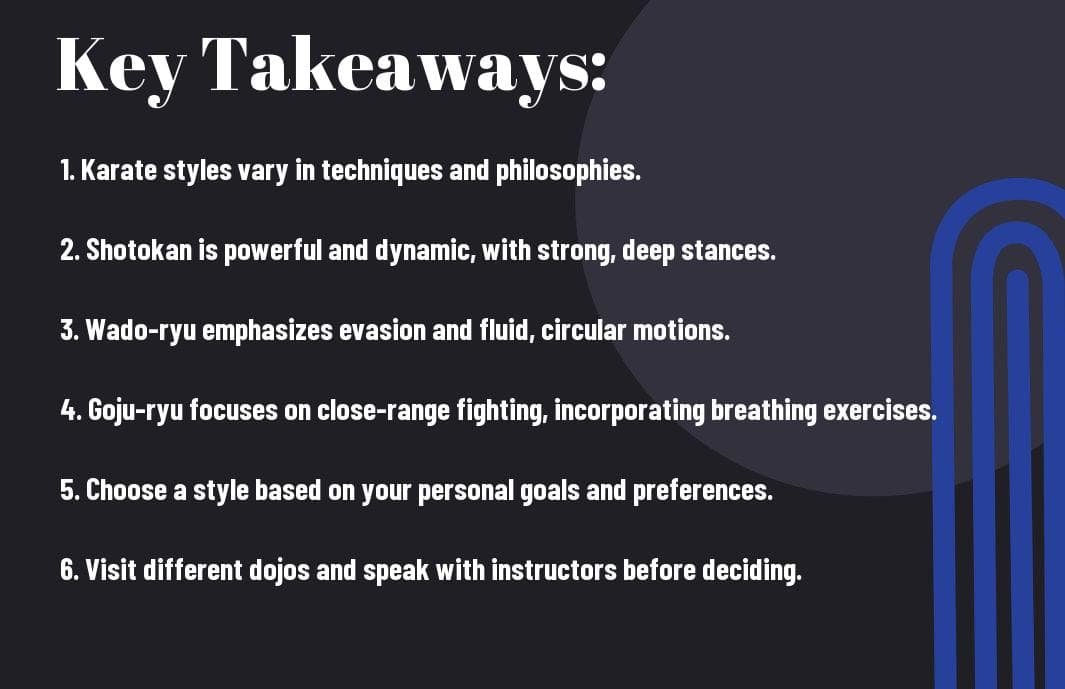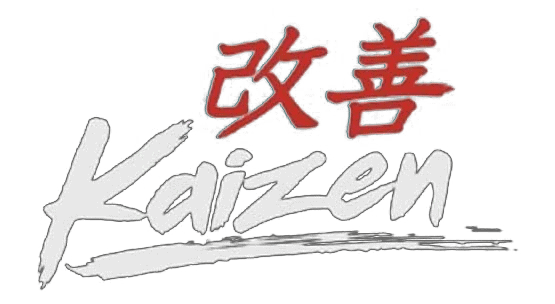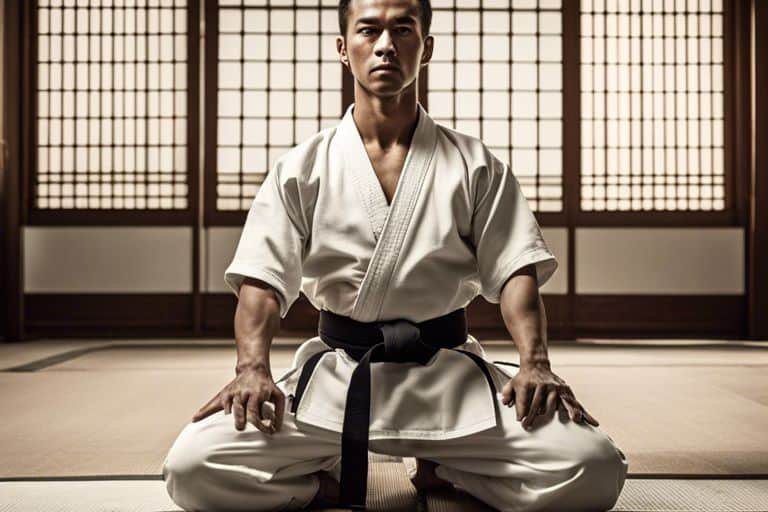Perplexed about which style of Karate to pursue? You’re not alone. With a plethora of options, it can be intimidating to determine which one is the best fit for your goals and preferences. In this informative blog post, we will explore the various styles of Karate, ranging from the traditional Shotokan to the dynamic and fast-paced Kyokushin. By the end, you’ll have a clearer understanding of which style aligns with your abilities, interests, and aspirations.
Key Takeaways:
- There are multiple styles of karate, each with its own unique techniques and philosophy.
- Traditional styles like Shotokan and Wado-Ryu focus on strong basics and forms, while styles like Kyokushin emphasise physical conditioning and full-contact sparring.
- The right karate style for you depends on your goals and preferences, such as whether you prefer a focus on self-defence, competition, or spiritual development.
- Researching and trying out different styles is essential to finding the one that resonates with you.
- Ultimately, the best karate style for you is one that aligns with your personal values, physical abilities, and long-term objectives.

The Historical Roots of Karate
You may be wondering about the origins of karate and how it has evolved over the years. To understand the different styles of karate, it’s important to delve into its historical roots.
Evolution of Karate Styles
The art of karate has undergone a significant evolution over the centuries, resulting in the development of various styles. These styles have been influenced by a range of factors, including geographical location, cultural traditions, and individual teachings. As a result, you will find that different karate styles emphasise various aspects of combat, self-defence, and personal development.
Influence of Cultural and Geographical Factors
The development of karate styles has been heavily influenced by cultural and geographical factors. For example, Okinawan karate, which is considered the foundation of modern karate, has been shaped by the traditions and customs of the Okinawan people. Additionally, the introduction of karate to Japan and its subsequent global spread has led to the emergence of distinct styles that reflect the cultural influences of their respective regions. Perceiving the influence of these factors is crucial in understanding the specific characteristics and principles of each karate style.
Major Styles of Karate
When it comes to choosing the right style of karate for you, it’s important to understand the major styles available and their unique characteristics. Each style has its own history, techniques, and emphasis, so it’s essential to explore each one to find the best fit for your goals and preferences.
Shotokan Karate
If you are looking for a powerful and dynamic style of karate, Shotokan may be the right choice for you. Emphasising strong, linear movements and deep stances, Shotokan is known for its focus on strength and speed. This style places a significant emphasis on the development of the lower body, with a range of strong, fast kicks and punches. Shotokan practitioners also train in kata, which are prearranged patterns of movements that simulate combat scenarios.
Goju-Ryu Karate
For those seeking a style that incorporates both hard and soft techniques, Goju-Ryu may be the ideal fit. This style places a strong emphasis on close-range fighting and circular movements, making it an excellent choice for self-defence applications. Goju-Ryu also focuses on controlled breathing and fostering inner strength, making it a well-rounded and holistic approach to karate training.
Wado-Ryu Karate
If you are interested in a more fluid and adaptable style of karate, Wado-Ryu may be the right choice for you. Known for its emphasis on evasion and redirection of an opponent’s energy, Wado-Ryu incorporates elements of jujitsu and karate, making it a versatile and well-rounded martial art. This style also places a strong emphasis on the development of timing and distancing, making it an excellent choice for practical self-defence.
Shito-Ryu Karate
Shito-Ryu is a style of karate that blends the hard and soft techniques of Okinawan karate, offering a balanced approach to combat. This style encompasses a wide range of techniques, from powerful strikes to fluid, circular movements, making it suitable for practitioners of all physical abilities. Shito-Ryu also places a strong emphasis on kata and kumite (sparring), providing a well-rounded training experience.
Kyokushin Karate
For those searching for a demanding and rigorous style of karate, Kyokushin may be the perfect fit. Known for its emphasis on full-contact sparring and rigorous physical conditioning, Kyokushin karate is not for the faint of heart. This style focuses on powerful, close-range strikes and kicks, developing unparalleled physical strength and toughness in its practitioners.
Choosing the Right Karate Style for You
When it comes to choosing the right karate style for you, there are a few factors to consider. Assessing your goals and fitness level, as well as considering the philosophical and physical attributes of each style, are crucial in making an informed decision.
Assessing Your Goals and Fitness Level
Before selecting a karate style, it’s important to assess your goals and fitness level. Are you looking to compete in tournaments, improve your physical fitness, or learn self-defence techniques? Consider whether you are a beginner or have previous martial arts experience. Assessing your goals and fitness level will help you determine which karate style aligns with your personal objectives and capabilities.
Considering the Philosophical and Physical Attributes of Each Style
Each karate style has its own philosophical and physical attributes that differentiate it from others. Some styles may focus more on self-defence techniques, while others emphasise competitive sparring. Additionally, certain styles may place a greater emphasis on discipline, respect, and personal development. It’s important to consider these aspects and how they align with your personal beliefs and preferences when choosing the right karate style for you.
Getting Started With Karate Training
So, you’ve decided to start your journey into the world of karate. It’s an exciting decision, and one that can have a profound impact on both your physical and mental well-being. However, before you can start throwing punches and kicks, there are a few important steps you need to take to get started with your karate training.
Finding a Dojo and Instructor
When it comes to choosing a dojo and instructor for your karate training, it’s crucial to do your research. Look for a dojo that is accredited by a reputable karate organisation and has experienced instructors who can provide you with the proper guidance and training. Take the time to visit different dojos, observe a few classes, and have a chat with the instructors to get a feel for the atmosphere and teaching style. It’s important to find a dojo and instructor that you feel comfortable with and who can support and challenge you in your karate journey.
Preparing for Your Karate Journey
Before you dive into your karate training, it’s important to prepare yourself physically and mentally. Karate training can be demanding, so it’s essential to ensure that you are in good physical condition before starting. You should also prepare yourself mentally for the discipline and focus required in karate training. This may involve setting goals for what you want to achieve in your training and mentally preparing yourself for the dedication required to reach those goals. Additionally, make sure that you have the right gear, such as a gi (uniform) and any protective equipment required for training. Lastly, make sure to familiarise yourself with the customs and etiquette of the dojo, including bowing and other traditional practices.
Conclusion
With these considerations in mind, you now have a better understanding of the different styles of karate and how they may suit your personal preferences and goals. Whether you are looking for a traditional and disciplined approach, a strong focus on self-defence, or a combination of both, there is a style of karate that is right for you. It is important to take the time to research and try out different styles, as well as consult with experienced instructors, in order to find the best fit for your individual needs. Remember, the right style of karate for you is the one that resonates with your interests, values, and ambitions.
FAQ
Q: What are the different styles of Karate?
A: The different styles of Karate include Shotokan, Wado-Ryu, Shito-Ryu, Goju-Ryu, and Kyokushin. Each style has its own unique characteristics and techniques.
Q: How do I know which Karate style is right for me?
A: The right Karate style for you depends on your personal goals, physical abilities, and preferences. It’s important to research and try out different styles before making a decision.
Q: What is Shotokan Karate?
A: Shotokan Karate is one of the most popular and widely practiced styles. It focuses on powerful and linear techniques, as well as a strong emphasis on kata (forms).
Q: What is Wado-Ryu Karate?
A: Wado-Ryu Karate is known for its emphasis on flexibility, body movements, and soft circular blocking techniques. It incorporates elements of Jujutsu and is more fluid compared to other styles.
Q: What is Shito-Ryu Karate?
A: Shito-Ryu Karate combines the hard and soft aspects of martial arts, incorporating both linear and circular movements. It also places importance on breathing and proper body alignment.
Q: What is Goju-Ryu Karate?
A: Goju-Ryu Karate focuses on close-quarters combat, circular blocking techniques, and breathing exercises. It also incorporates hard and soft techniques, making it a well-rounded style.
Q: What is Kyokushin Karate?
A: Kyokushin Karate is known for its full-contact style and emphasis on physical conditioning. It is characterized by powerful kicks and punches, as well as rigorous training regimens.
Q: How can I determine which Karate style suits me best?
A: To determine which Karate style is best for you, consider your fitness level, flexibility, and comfort with different techniques. Try out classes in different styles and speak with instructors to find the best fit for your goals and abilities.



